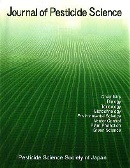Volume 36, Issue 3
Displaying 1-19 of 19 articles from this issue
- |<
- <
- 1
- >
- >|
English Articles
Original Articles
-
Article type: Original Article
2011 Volume 36 Issue 3 Pages 347-356
Published: August 25, 2011
Released on J-STAGE: August 21, 2011
Advance online publication: May 07, 2011Download PDF (830K) -
Article type: Original Article
2011 Volume 36 Issue 3 Pages 357-362
Published: August 25, 2011
Released on J-STAGE: August 21, 2011
Advance online publication: May 07, 2011Download PDF (753K) -
Article type: Original Article
2011 Volume 36 Issue 3 Pages 363-369
Published: August 25, 2011
Released on J-STAGE: August 21, 2011
Advance online publication: June 04, 2011Download PDF (1017K) -
Article type: Original Article
2011 Volume 36 Issue 3 Pages 370-375
Published: August 25, 2011
Released on J-STAGE: August 21, 2011
Advance online publication: June 11, 2011Download PDF (529K) -
Article type: Original Article
2011 Volume 36 Issue 3 Pages 376-384
Published: August 25, 2011
Released on J-STAGE: August 21, 2011
Advance online publication: May 28, 2011Download PDF (679K) -
Article type: Original Article
2011 Volume 36 Issue 3 Pages 385-391
Published: August 25, 2011
Released on J-STAGE: August 21, 2011
Advance online publication: July 17, 2011Download PDF (936K) -
Article type: Original Article
2011 Volume 36 Issue 3 Pages 392-401
Published: August 25, 2011
Released on J-STAGE: August 21, 2011
Advance online publication: July 16, 2011Download PDF (840K)
Note
-
Article type: Note
2011 Volume 36 Issue 3 Pages 402-406
Published: August 25, 2011
Released on J-STAGE: August 21, 2011
Advance online publication: June 11, 2011Download PDF (412K)
Society Awards 2011
-
Article type: Original Article
2011 Volume 36 Issue 3 Pages 407-409
Published: August 25, 2011
Released on J-STAGE: August 21, 2011
Advance online publication: July 27, 2011Download PDF (403K) -
Article type: Society Awards 2011
2011 Volume 36 Issue 3 Pages 410-411
Published: August 25, 2011
Released on J-STAGE: August 21, 2011
Advance online publication: July 28, 2011Download PDF (404K)
PART II (IN JAPANESE)
Original Article
-
Article type: Original Article
2011 Volume 36 Issue 3 Pages 413-427
Published: August 25, 2011
Released on J-STAGE: November 10, 2012
Download PDF (2507K)
The Society Award Lectures
-
Article type: The Society Award Lectures
2011 Volume 36 Issue 3 Pages 428-433
Published: August 25, 2011
Released on J-STAGE: November 10, 2012
Download PDF (1118K) -
Article type: The Society Award Lectures
2011 Volume 36 Issue 3 Pages 434-439
Published: August 25, 2011
Released on J-STAGE: November 10, 2012
Download PDF (1259K) -
Article type: The Society Award Lectures
2011 Volume 36 Issue 3 Pages 440-442
Published: August 25, 2011
Released on J-STAGE: November 10, 2012
Download PDF (561K)
Abstracts of Articles in Part I
-
2011 Volume 36 Issue 3 Pages 443-444
Published: August 25, 2011
Released on J-STAGE: December 01, 2012
Download PDF (247K)
Seminar: Experimental Techniques (Part 3)
-
Article type: Seminar: Experimental Techniques (Part 3)
2011 Volume 36 Issue 3 Pages 445-454
Published: August 25, 2011
Released on J-STAGE: November 10, 2012
Download PDF (2878K)
Book Review
-
Article type: Book Review
2011 Volume 36 Issue 3 Pages 455-
Published: August 25, 2011
Released on J-STAGE: November 10, 2012
Download PDF (496K)
Obituary
-
Article type: Obituary
2011 Volume 36 Issue 3 Pages 457-458
Published: August 25, 2011
Released on J-STAGE: November 10, 2012
Download PDF (1072K)
Erratum
-
Article type: Erratum
2011 Volume 36 Issue 3 Pages 459-
Published: August 25, 2011
Released on J-STAGE: November 10, 2012
Download PDF (4852K)
- |<
- <
- 1
- >
- >|
